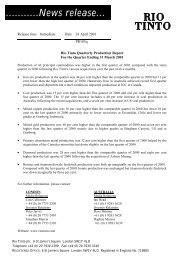Luzenac 20-pages - Rio Tinto
Luzenac 20-pages - Rio Tinto
Luzenac 20-pages - Rio Tinto
You also want an ePaper? Increase the reach of your titles
YUMPU automatically turns print PDFs into web optimized ePapers that Google loves.
talc the mineral<br />
14 <strong>Luzenac</strong><br />
Talc, the mineral that contributes<br />
to sustainable development<br />
At <strong>Luzenac</strong>, sustainable development also means developing new,<br />
environmentally safe and friendly products for a sustainable society.<br />
Indeed, in many of its applications—be it paper, paint, plastics, ceramics,<br />
etc.—talc not only brings value to our customers, it enhances their<br />
own environmental and sustainable development activities.<br />
Dashboard and interior parts<br />
The use of talc in polypropylene for interior components<br />
such as dashboards, pillar trim and consoles increases<br />
dimensional stability and stiffness enabling downgauging<br />
Catalytic converters<br />
Honeycomb talc-based cordierite structures are a<br />
critical component in today’s catalytic converters and<br />
particle filters<br />
Bumpers<br />
Very fine talcs provide polypropylene bumpers with the<br />
right balance of rigidity and impact strength, allowing<br />
them to be made thinner and lighter<br />
Tyres<br />
Talc powdering accelerates tyre demoulding cycles,<br />
thus reducing energy costs<br />
Door sealants<br />
Incorporating talc into door sealants improves<br />
weathering and extends product life<br />
Take the average car. Talc is an important ingredient in a number of automotive<br />
components where it brings environmental benefits. For instance, talc imparts stiffness and<br />
other crucial properties to polypropylene, which has replaced less environmentally friendly<br />
plastics such as PVC and ABS in a broad array of car parts. Polypropylene is easily recyclable<br />
and its use enables car manufacturers to down-gauge parts, contributing to making cars<br />
generally lighter and lowering fuel consumption. Talc is also one of the principal components<br />
of ceramic cordierite, which is used as a support in today’s catalytic converters and diesel particle<br />
filters for automotive exhaust systems.<br />
For more examples of how talc contributes<br />
to the environment in other applications,<br />
consult our <strong>20</strong>02 SD report on www.luzenac.com<br />
Under the bonnet / hood components<br />
Tough, lightweight polypropylene parts containing up<br />
to 40% of talc have replaced many of the metal components<br />
in car engines, such as heating, ventilation and<br />
air conditioning units<br />
Bodywork<br />
Talc improves the rigidity of polypropylene making it a<br />
viable replacement for metal in bodywork parts.<br />
Using plastics for bodywork:<br />
• reduces overall vehicle weight hence fuel consumption<br />
• eliminates the use of paint with its associated volatile<br />
organic compounds<br />
• provides greater design freedom<br />
• improves recyclability<br />
• enhances safety features


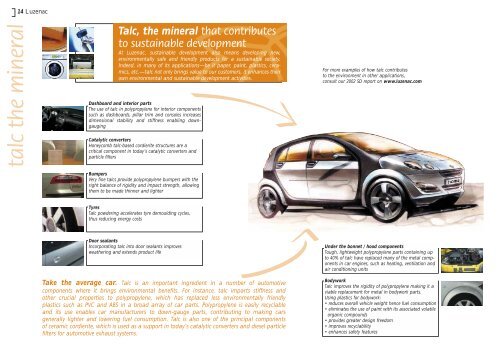
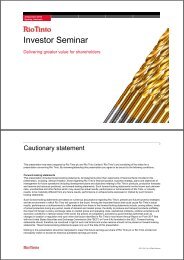


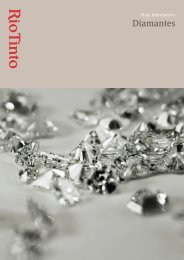


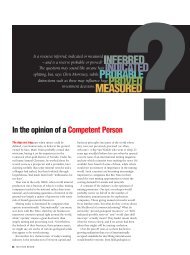


![Download pdf file [PDF: 1.26 MB] - Rio Tinto](https://img.yumpu.com/10319684/1/190x253/download-pdf-file-pdf-126-mb-rio-tinto.jpg?quality=85)

